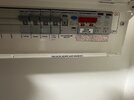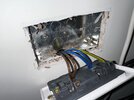- Joined
- 7 Jan 2020
- Messages
- 20
- Reaction score
- 0
- Country

Hi all,
I live in a 2022 new build and I’m planning on adding a double socket from spurring an existing double socket on the ring main in the adjacent room using 2.5mm T&E. The wall is a partition stud wall which is insulated. The new socket will be installed higher up the wall in the adjacent room to power a wall mounted TV.
I have checked the double socket I am planning to spur off and there are two cables, one in and one out. The circuit is RCD protected with a B32 breaker.
To my understanding if one spur is coming off the ring, then a 13A FCU is not required. However, I had other additional sockets added during the build in other rooms to power wall mounted TVs (this one was an oversight) and the electrician has spurred to an FCU and then into the double socket.
I’m just wondering what I’ve missed as from what I could see, an FCU wouldn’t be necessary?
Is it necessary to run the T&E in conduit in an insulated stud wall? Or not as it is RCD protected?
Many thanks


I live in a 2022 new build and I’m planning on adding a double socket from spurring an existing double socket on the ring main in the adjacent room using 2.5mm T&E. The wall is a partition stud wall which is insulated. The new socket will be installed higher up the wall in the adjacent room to power a wall mounted TV.
I have checked the double socket I am planning to spur off and there are two cables, one in and one out. The circuit is RCD protected with a B32 breaker.
To my understanding if one spur is coming off the ring, then a 13A FCU is not required. However, I had other additional sockets added during the build in other rooms to power wall mounted TVs (this one was an oversight) and the electrician has spurred to an FCU and then into the double socket.
I’m just wondering what I’ve missed as from what I could see, an FCU wouldn’t be necessary?
Is it necessary to run the T&E in conduit in an insulated stud wall? Or not as it is RCD protected?
Many thanks


